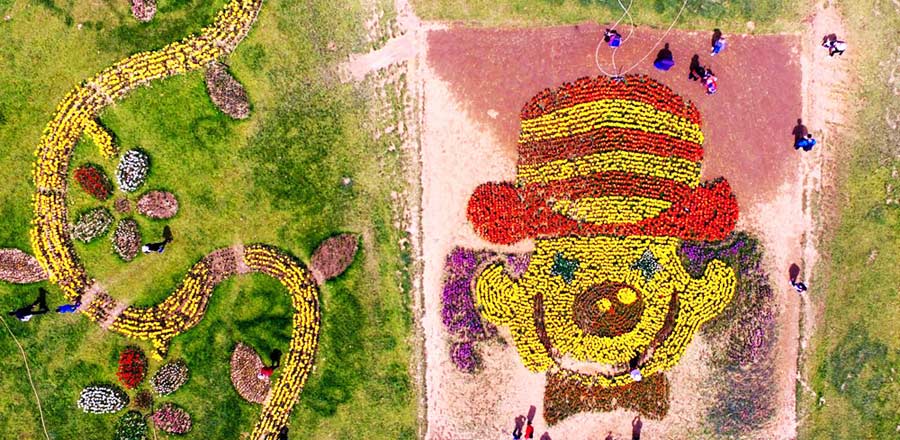
Dogs' special skills put to use by mailrooms, border guards, airports
In an inconspicuous courtyard in Beijing's suburban Tongzhou district, 44 dogs have been working hard to learn a range of skills and hone their ability to quickly identify a wide selection of smells.
They are put through their paces from Monday to Friday, normally from 9 am to 5 pm, and, despite their heavy workload, keep fit, thanks to an exercise regime that includes stints on a treadmill.
"Dogs are like humans, some of them learn more quickly," said Liu Yan, a trainer at the Tongzhou base that is run by the Beijing Entry-Exit Inspection and Quarantine Bureau. "It is not easy to train a dog to become an excellent inspection dog."
The most difficult part lies in teaching the animals to identify the many smells they will encounter, he said.
"Normally, 4,000 to 6,000 repetitions of the same training is required before a dog can identify a single source of a smell," Liu said.
The number of inspection dogs being trained at the base, which occupies a 0.67-hectare site and is the only such facility in China, fluctuates because some of them fail to complete the program, he said.
Since the first four trained labradors started working at Beijing Capital International Airport in 2002, the bureau has trained and put into service 129 inspection dogs. The dogs are all either springer spaniels, labradors or beagles. Eighty of them are in service outside the capital, at ports throughout China, according to the bureau.
In Beijing alone, during the first quarter of the year, the inspection dogs helped intercept 3,287 shipments that should not have been brought into China. The goods weighed a total of more than 8 metric tons, the bureau said.
Among the items intercepted by the dogs in Beijing during the past 15 years were invasive animal and plant species that could have seriously damaged agricultural production.
The General Administration of Quality Supervision, Inspection and Quarantine is investing in better detecting equipment, including CT scanners, and is planning to build two national centers, one in Beijing and the other possibly in Guangdong province, to breed and train inspection dogs so it can keep up with increased pressure on entry and exit points.
Zhao Zenglian, deputy head of the Department of Supervision on Animal and Plant Quarantine under the administration, said the dogs are a great resource because they are more versatile and approachable than traditional scanning equipment, such as X-ray machines, and are more successful as a result in sniffing out such things as harmful invasive species.
Zhao said there are currently 269 inspection dogs keeping a nose on China's 280 major ports. He believes more than 1,000 may eventually be needed.
The two centers will be finished in the next five years and house at least 200 inspection dogs each at a time, he said.
Wang Xiping, director of special inspections under the bureau, said the new national training and breeding center in Beijing is likely to be built in the southern part of the city, near the second international airport that is under construction.
Training programs start when the dogs are three to four months old and usually take around three to four months to complete, Wang said.
Once dogs start working, they usually inspect parcels and packages for a day before having three days off for rest and additional training. The main target of their sensitive noses are fruit, meat, dairy products and aquatics products hidden in luggage, Wang said.
The Tongzhou base has also successfully trained three dogs that are capable of sniffing out plant seeds, items that tend to give off little smell and are usually difficult to spot. The dogs inspect international mail and parcels bound for Beijing, he said.
Wang, chief of special inspections at the bureau, said the dogs work hard and are usually ready for retirement at age 8. He said many carry on living at the training center after they retire but some get new homes and owners.
More species intercepted at the Chinese border
Inspection and quarantine authorities in China intercepted more than 16,000 shipments of harmful species and stopped them from entering China in the first quarter of this year, an increase of nearly 90 percent compared with the same period last year, according to the General Administration of Quality Supervision, Inspection and Quarantine.
The species - found in luggage carried by passengers or mailed in parcels - were among the nearly 130,000 animals, plants and their products banned from entry into China, said Li Jing, spokeswoman for the administration.
In addition, inspection authorities intercepted 3,043 shipments of harmful species when inspecting imported agricultural products in the first quarter, she said.
Most of the intercepted species were weeds and insects, Li said.
The species were mostly from China's main trading partners, such as the United States, Kazakhstan, Canada, Australia, New Zealand, Japan and Thailand, she said.
All the parcels containing harmful species were properly treated, sent back to their original countries or destroyed to prevent the spread of disease, she said.
wangxiaodong@chinadaily.com.cn
|
A labrador walks on a treadmill during a training session in April at the inspection dog training base of the Beijing EntryExit Inspection and Quarantine Bureau. Photos By Zou Hong / China Daily |
|
Top: An intern trainer interacts with a beagle during a training session. Bottom: A Kunming dog, a breed of wolfdog originated in China, is trained to fetch by a handler. |
(China Daily 05/05/2016 page4)













